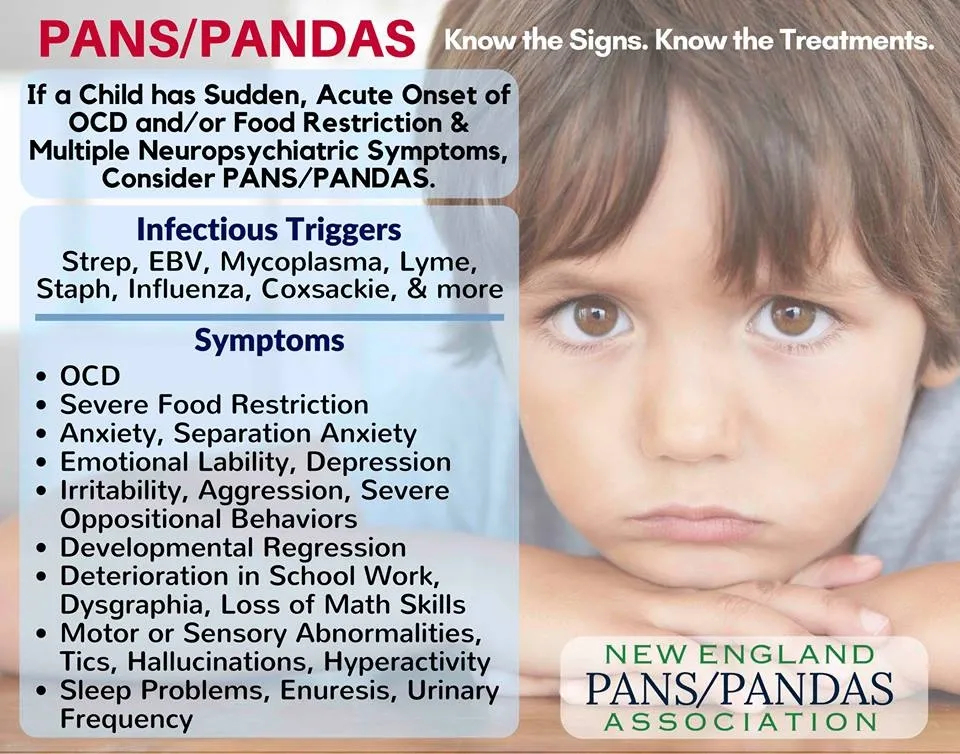PANDAS/PANS (Not a Cuddly Animal and Not Cooking Utensils)
Pediatric Autoimmune Neuropsychiatric Disorder Associated with Streptococcal Infections (PANDAS) and Pediatric Acute-Onset Neuropsychiatric Syndrome (PANS) are a pair of previously unheard-of conditions that are quickly becoming household names. Both conditions are autoimmune diseases caused by chronic infections. Strep was the first known infection to cause the symptoms we will discuss, which is why it has its very own diagnosis with PANDAS. It was then discovered that any type of infection has the potential to cause this condition, which is where the diagnosis of PANS came to be.
PANDAS/PANS occurs when a child is exposed to a virus, bacteria or even fungi (mold), where the acute infection was not fully treated. While a child who ends up getting recurring strep throat is at high risk of receiving a PANDAS diagnosis, even a single exposure can trigger it. Influenza, mold, Lyme, Bartonella, and a long list of other infections are known triggers for PANS.
When the attacking microbe enters the body, it settles in the safest place it can find to stay undetected by the immune system. Often, this means within tissues and a substance called biofilm, which is a slimy, plaque-like substance made up of bacteria that stick together and form mini-habitats for microbes to flourish (imagine the plaque on your teeth). Biofilms can be found anywhere in the body, including the major organs and brain. Within the biofilm, there is little to no oxygen, so anaerobic (oxygen avoiding) viruses and bacteria will proliferate, often for decades. During this time, the microbes are active and able to cause infections and acute symptoms, but will mostly be dormant; they also disguise themselves to appear like they belong there, so immune cells don’t recognize them as the foreign invaders they are. For adults, this can result in no outward symptoms of infection for many years. However, when they get sick, sometimes it will trigger the dormant microbes and cause an inflammatory “flare” that can be mild or severe. Symptoms often include fever, lethargy, tiredness, swelling of joints and cartilage and allergy-like symptoms. Often the triggering microbe goes undiagnosed and the patient will receive a fibromyalgia or multiple sclerosis diagnosis as the flares get worse with each immune response.
When the same conditions happen in a child, the effects can be devastating. When the child is exposed to an environmental trigger or has any type of immune response, the resulting PANDAS/PANS flare can turn a typically docile child into an unpredictable, raging one. Instead of the body producing antibodies to fight the infection, it instead attacks the body’s own tissues, especially the brain. This is how PANDAS/PANS constitutes as an autoimmune disease. Symptoms can happen literally overnight in a child with a recent exposure to an infectious microbe. It is also noted that exposure to a toxic substance such as pollution, pesticides, mold, heavy metals, ect. can trigger flares. Initially, most parents notice a sudden on-set of severe obsessive compulsive disorder, which can look like sudden germaphobia or constant body movements (tics). Other symptoms include deterioration of hand writing, anxiety, rage, talk of suicide, bed-wetting, separation anxiety, behavioral and age regression, sleep disturbances, all over physical pain, hallucinations, and fight or flight response. Flares can last up weeks in some children and when they are over, the child immediately returns to the same state they were before the flare. They can remember feeling helpless, angry and uncontrollable during their flares and will often carry residual depression.
Treatment for PANDAS and PANS is not a one-size-fits-all. Research is still catching up with parents who have been experiencing this scary disorder for many years. Some top doctors don’t yet even believe it’s a real disorder. Some treatments include strong antibiotics given long term, herbal regimens, homeopathy, IVIG, Nuerofeedback, nutrition,detoxification, chiropractic, behavioral therapy, acupuncture, hyperbaric oxygen therapy, and much more. More often than not, multiple protocols have to be implemented to see a control of flares. Families often spend years and thousands of dollars looking for the answer for their child, and often, failing. For children with mold triggers, removing them from their environments can be all they need. Others have multiple triggering infections that each need to be targeted with different treatments. We are hopeful that as we learn more about PANDAS/PANS, more cutting edge research will reveal a more standardized treatment protocol.
How can hyperbaric oxygen therapy specifically help with PANDAS/PANS? First, it is an anti-inflammatory modality; the extra oxygen taken to areas of infection can reduce the inflammation and even break up the anaerobic biofilm, releasing the triggering microbes into the bloodstream. While this seems like a negative, it means that now that the microbes can’t hide in the biofilm anymore, the treatment protocols (including oxygen) will be more effective at killing the infection. HBOT can also help a child during a flare by inducing a relaxation effect which will help take the child out of a fight or flight response. This can result in less anxiety and rage episodes. We highly recommend a child with PANDAS or PANS get hyperbaric therapy on a regular basis to help treat the infections and reduce the symptoms during flares.
To learn more about PANDAS/PANS, we recommend going to http://pandasnetwork.org/

